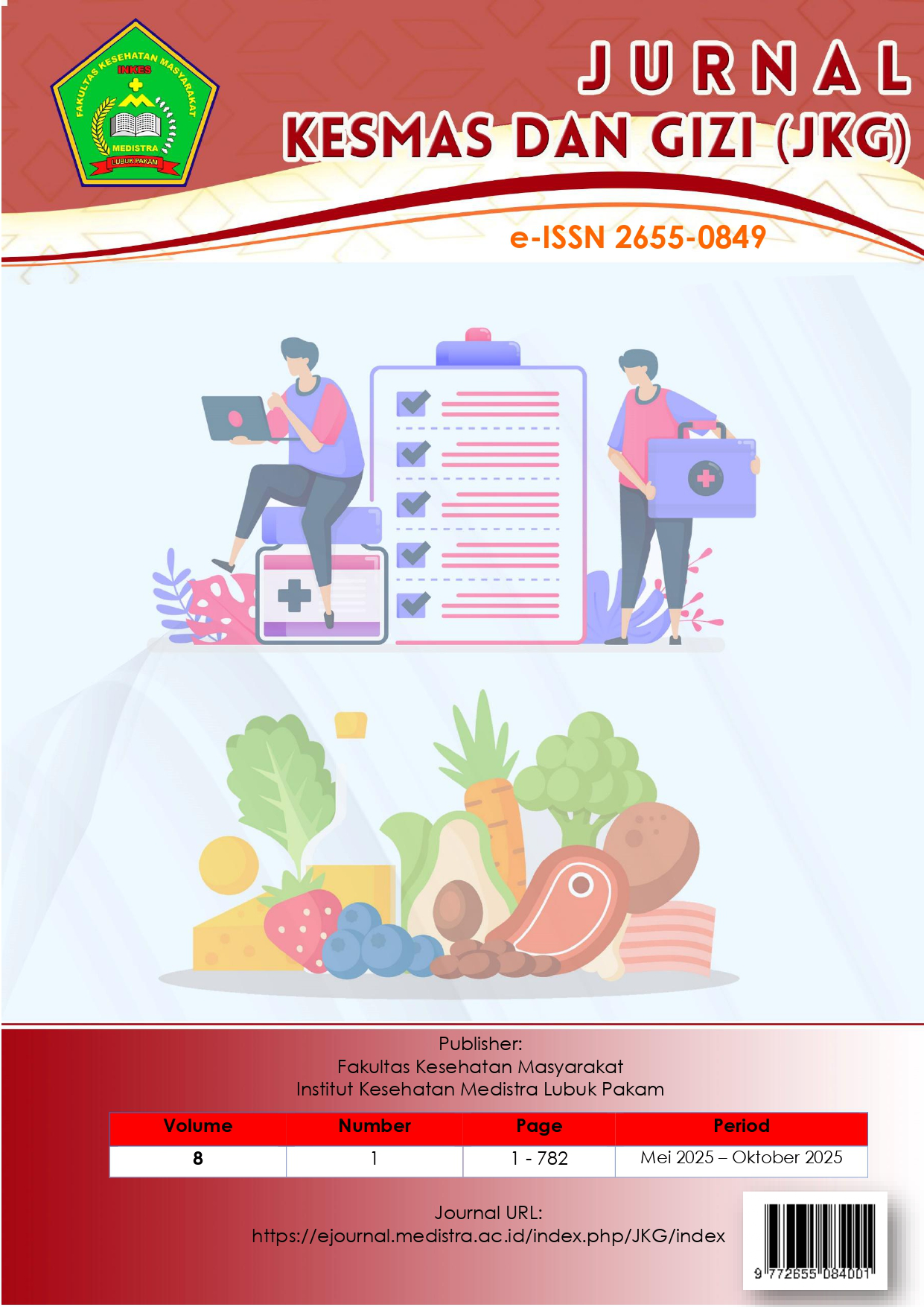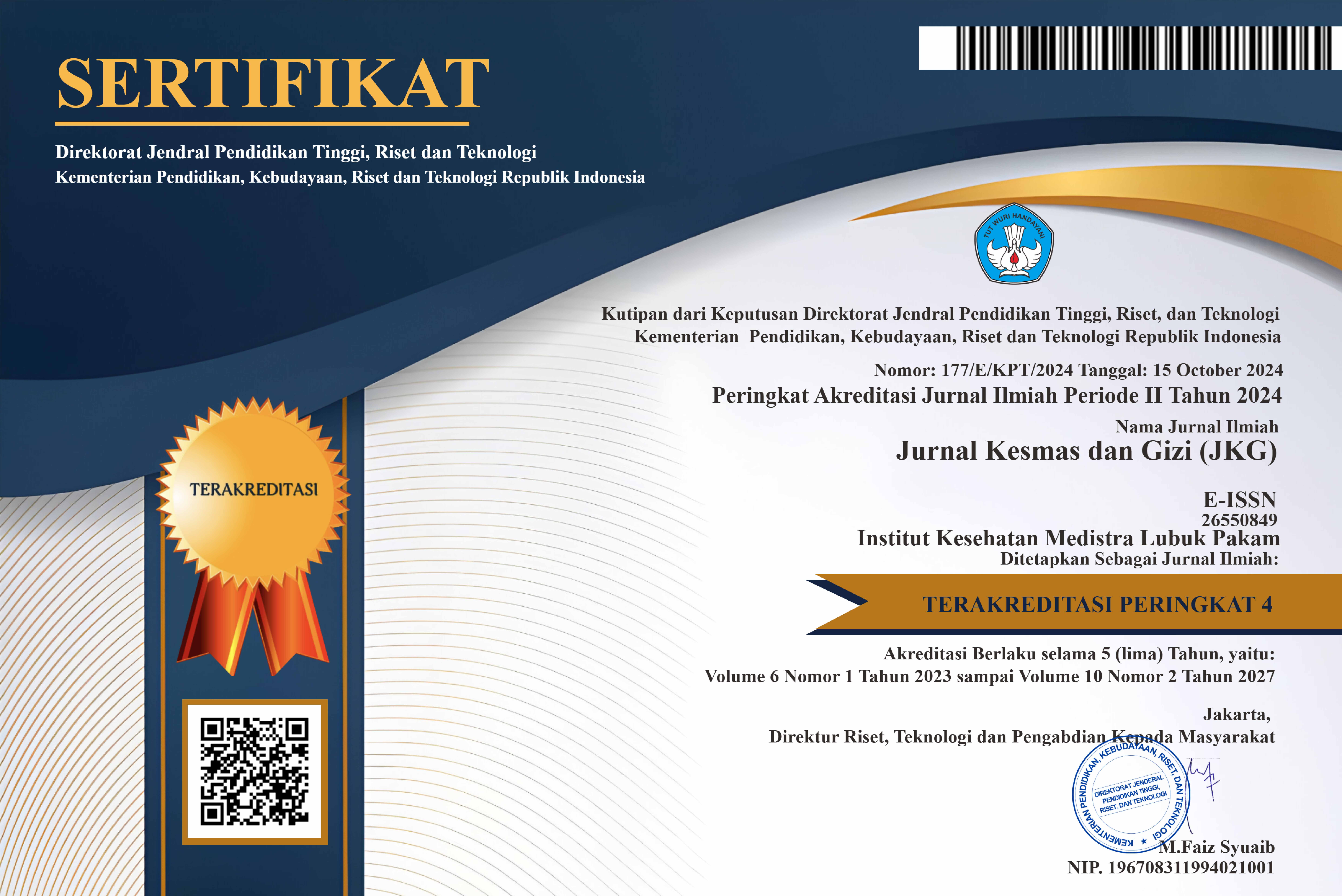The Effect of Health Insurance Ownership, Travel Time, and Transportation Costs on the Use of Health Facilities by Stunted Toddlers in North Sumatera Province
DOI:
https://doi.org/10.35451/5evn8x84Keywords:
Stunting, fasilitas kesehatan, jaminan kesehatan, waktu, biayaAbstract
One of the causes of stunting is limited access to health care and essential services. Based on SKI 2023 data, there are still stunted toddlers in North Sumatera who have not used healthcare facilities in the past year since the survey was conducted. The purpose of this study was to analyze the determinants of healthcare facilities utilization in stunted toddlers in North Sumatera, focusing on the factors of health insurance ownership, travel time, and transportation costs. The study design used was cross-sectional with a sample size of 801 stunted toddlers aged 24-59 months in North Sumatera. Univariate data analysis was performed by presenting the results in the form of frequency tables, bivariate analysis using chi-square, and multivariate analysis using logistic regression. Based on the results of bivariate analysis using the chi-square test, it was found that there was no effect of health insurance ownership (p=0.059) and travel time (p=0.108), and there was an effect of transportation costs (p=0.001) on the use of healthcare facilities. Multivariate analysis using logistic regression showed that the variable of transportation costs (p=0.001) had a significant effect on the use of healthcare facilities with an Odd Ratio (OR) value of 3.894. This shows that transportation costs are still a barrier to accessing health care, especially for stunted toddlers. Therefore, a service approach through home visits could be a potential solution so that high transportation costs no longer become a barrier to accessing health services.
Downloads
References
[1] World Health Organization. Reducing stunting in children: Equity considerations for achieving the Global Nutrition Targets 2025. 2018.
[2] TPPS. Strategi Nasional Percepatan Pencegahan Anak Kerdil (Stunting) 2020. https://stunting.go.id/stranas-p2k/ (accessed 1 September 2025).
[3] WHO. Joint child malnutrition estimates 2025. https://www.who.int/data/gho/data/themes/topics/joint-child-malnutrition-estimates-unicef-who-wb (accessed 26 June 2025).
[4] Kemenkes BKPK. Survei Kesehatan Indonesia (SKI). 2023.
[5] Kementerian Kesehatan RI. SSGI 2024 Dalam Angka. 2025.
[6] Thuong NTT. Impact of health insurance on healthcare utilisation patterns in Vietnam: a survey-based analysis with propensity score matching method. BMJ Open 2020;10:1–12. https://doi.org/10.1136/bmjopen-2020-040062.
[7] Ipa M, Laksono AD, Wulandari RD. The role of travel time on hospital utilization in the islands area: A cross-sectional study in the Maluku Region, Indonesia, in 2018. Indian J Community Med 2023;48:269–73. https://doi.org/10.4103/ijcm.ijcm_229_22.
[8] Cochran AL, McDonald NC, Prunkl L, Vinella-Brusher E, Wang J, Oluyede L, et al. Transportation barriers to care among frequent health care users during the COVID pandemic. BMC Public Health 2022;22:1–10. https://doi.org/10.1186/s12889-022-14149-x.
[9] Mentari GB, Susilawati. Faktor-faktor yang mempengaruhi akses pelayanan kesehatan di Indonesia. J Heal Sains 2022;33:1–12. https://doi.org/10.46799/jhs.v4i06.512.
[10] Zhang C, Fu C, Song Y, Feng R, Wu X, Li Y. Utilization of public health care by people with private health insurance: A systematic review and meta-analysis. BMC Public Health 2020;20:1–12. https://doi.org/10.1186/s12889-020-08861-9.
[11] Li J, Li Y. Factors affecting utilization of healthcare services in Australia. Highlights Sci Eng Technol 2022;8:185–93. https://doi.org/10.54097/hset.v8i.1126.
[12] Bousmah MAQ, Diakhaté P, Toulao GÀD, Le Hesran JY, Lalou R. Effects of a free health insurance programme for the poor on health service utilisation and financial protection in Senegal. BMJ Glob Heal 2022;7:1–10. https://doi.org/10.1136/bmjgh-2022-009977.
[13] Kolukuluri K. Healthcare utilization and outcomes for insured dependent children: evidence from Indonesia. Empir Econ 2022;63:945–77. https://doi.org/10.1007/s00181-021-02146-9.
[14] Noerjoedianto D, Solida A, Mekarisce AA. Study on the utilization of National Health Insurance Participants for Contribution Assistance Recipients Jambi City. Int J Health Sci (Qassim) 2022;2:66–71. https://doi.org/https://doi.org/10.55606/ijhs.v2i2.322.
[15] Andersen RM. Revisiting the Behavioral Model and access to medical care: Does it matter? J Health Soc Behav 1995;36:1–10. https://doi.org/http://www.jstor.org/stable/2137284.
[16] Shami E, Tabrizi JS, Nosratnejad S. The Effect of Health Insurance on the utilization of health services: A systematic review and meta-analysis. Galen Med J 2019;8:1411. https://doi.org/10.31661/gmj.v8i0.1411.
[17] Arviana ME, Hafidz F, Setiyaningsih H. The relationship between health insurance ownership and health service utilization, out-of-pocket expenses, and catastrophic health expenditure in the Special Region of Yogyakarta in 2023. BIO Web Conf 2024;132. https://doi.org/10.1051/bioconf/202413204002.
[18] David NK, Mwaura-Tenambergen W, Mapesa J. Effects of health insurance schemes on utilization of healthcare services and financial risk protection: A systematic review. Public Heal Res 2020;10:123–32. https://doi.org/10.5923/j.phr.20201004.03.
[19] Shende V, Wagh V. Public health insurance status and utilization of healthcare services across India: A narrative review. Cureus 2024;16:1–9. https://doi.org/10.7759/cureus.54308.
[20] Bai R, Gao J, Dong W. Is travel time associated with health service utilization in Northwest China? Evidence from Shaanxi Province. Int J Gen Med 2022;15:4949–57. https://doi.org/10.2147/IJGM.S360582.
[21] McGaughey T, Peters PA. Where should we go - Estimating travel times for modelling accessibility to 24-hour emergency departments in Canada. Sci Data 2024;11:1–8. https://doi.org/10.1038/s41597-024-03691-5.
[22] Stentzel U, Bahr J, Fredrich D, Piegsa J, Hoffmann W, Van Den Berg N. Is there an association between spatial accessibility of outpatient care and utilization? Analysis of gynecological and general care. BMC Health Serv Res 2018;18:1–11. https://doi.org/10.1186/s12913-018-3143-5.
[23] Jang SY, Seon JY, Oh IH. Influencing factors of transportation costs regarding healthcare service utilization in Korea. J Korean Med Sci 2020;35:1–14. https://doi.org/10.3346/JKMS.2020.35.E290.
[24] Keeves J, Gabbe B, Arnup S, Ekegren C, Beck B. Serious injury in Metropolitan and Regional Victoria: Exploring travel to treatment and utilisation of post-discharge health services by injury type. Int J Environ Res Public Health 2022;19. https://doi.org/10.3390/ijerph192114063.
[25] Wolfe MK, McDonald NC. Innovative health care mobility services in the US. BMC Public Health 2020;20:1–9. https://doi.org/10.1186/s12889-020-08803-5.
Downloads
Published
Issue
Section
License
Copyright (c) 2025 Syafrina Ulfah, Fithri Handayani Lubis, Hengki Frengki Manullang

This work is licensed under a Creative Commons Attribution 4.0 International License.
Copyright in each article is the property of the Author.


























